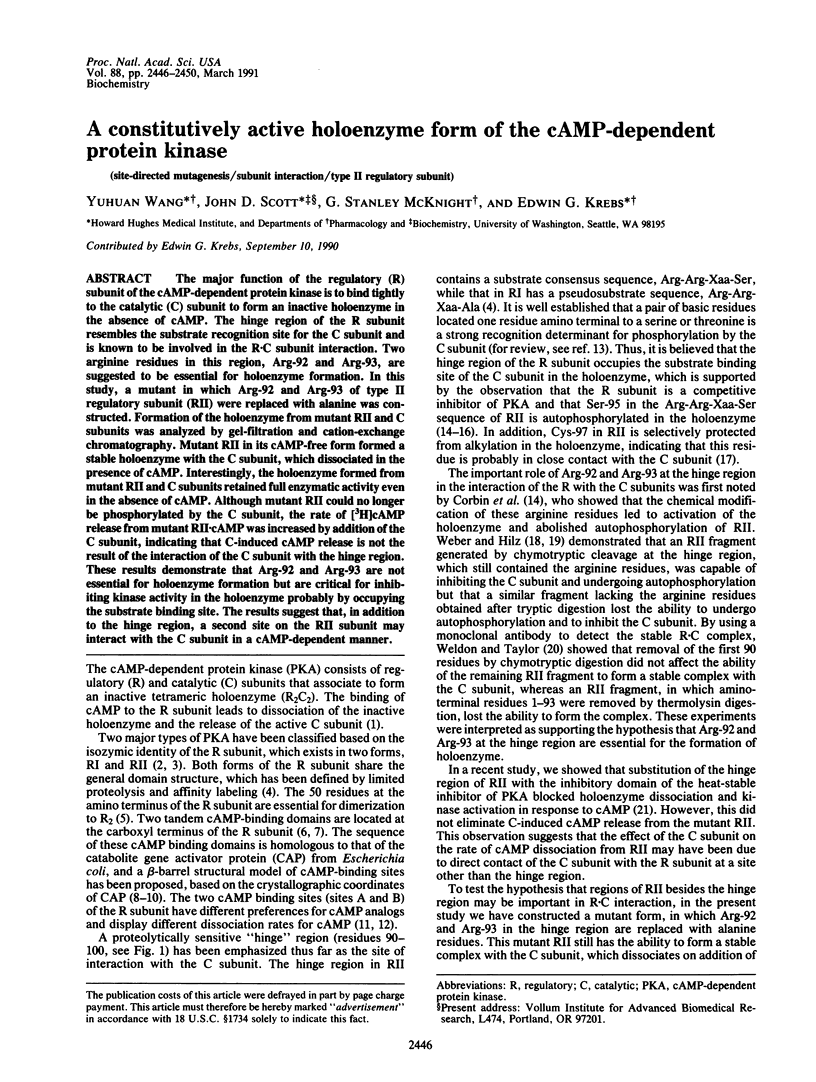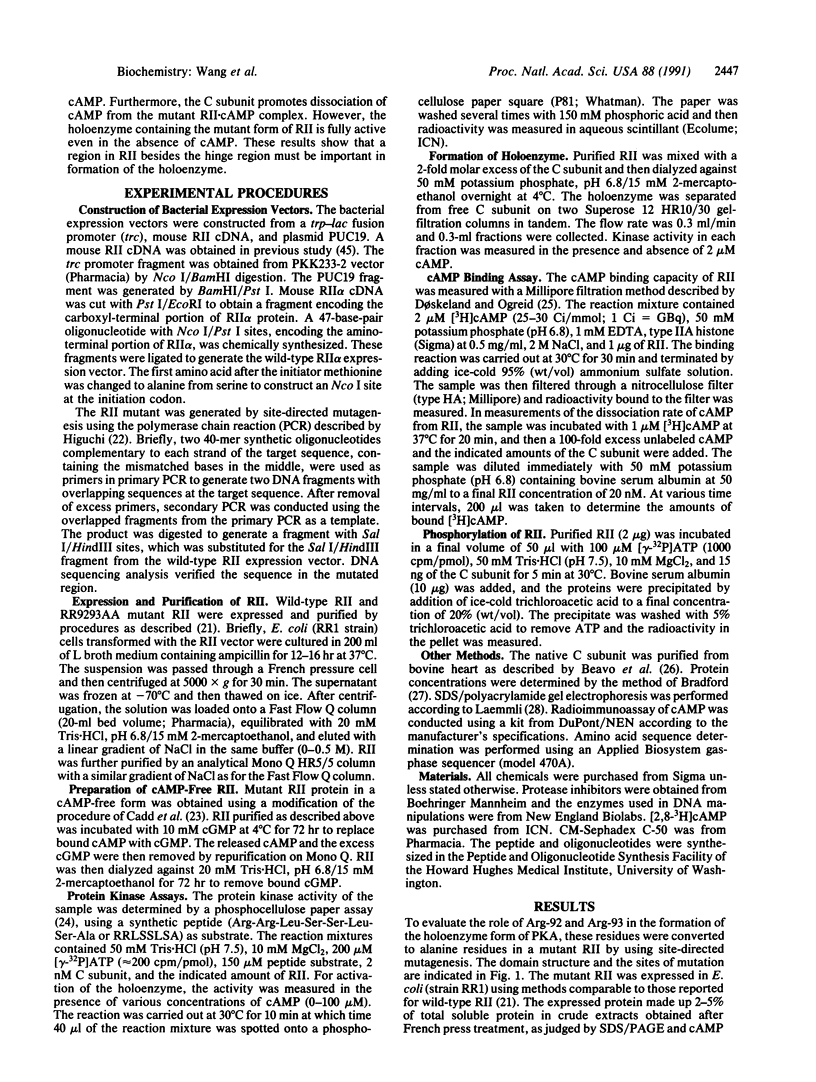Abstract
The major function of the regulatory (R) subunit of the cAMP-dependent protein kinase is to bind tightly to the catalytic (C) subunit to form an inactive holoenzyme in the absence of cAMP. The hinge region of the R subunit resembles the substrate recognition site for the C subunit and is known to be involved in the R.C subunit interaction. Two arginine residues in this region, Arg-92 and Arg-93, are suggested to be essential for holoenzyme formation. In this study, a mutant in which Arg-92 and Arg-93 of type II regulatory subunit (RII) were replaced with alanine was constructed. Formation of the holoenzyme from mutant RII and C subunits was analyzed by gel-filtration and cation-exchange chromatography. Mutant RII in its cAMP-free form formed a stable holoenzyme with the C subunit, which dissociated in the presence of cAMP. Interestingly, the holoenzyme formed from mutant RII and C subunits retained full enzymatic activity even in the absence of cAMP. Although mutant RII could no longer be phosphorylated by the C subunit, the rate of [3H]cAMP release from mutant RII.cAMP was increased by addition of the C subunit, indicating that C-induced cAMP release is not the result of the interaction of the C subunit with the hinge region. These results demonstrate that Arg-92 and Arg-93 are not essential for holoenzyme formation but are critical for inhibiting kinase activity in the holoenzyme probably by occupying the substrate binding site. The results suggest that, in addition to the hinge region, a second site on the RII subunit may interact with the C subunit in a cAMP-dependent manner.
Full text
PDF




Images in this article
Selected References
These references are in PubMed. This may not be the complete list of references from this article.
- Beavo J. A., Bechtel P. J., Krebs E. G. Preparation of homogeneous cyclic AMP-dependent protein kinase(s) and its subunits from rabbit skeletal muscle. Methods Enzymol. 1974;38:299–308. doi: 10.1016/0076-6879(74)38046-9. [DOI] [PubMed] [Google Scholar]
- Bradford M. M. A rapid and sensitive method for the quantitation of microgram quantities of protein utilizing the principle of protein-dye binding. Anal Biochem. 1976 May 7;72:248–254. doi: 10.1016/0003-2697(76)90527-3. [DOI] [PubMed] [Google Scholar]
- Cadd G. G., Uhler M. D., McKnight G. S. Holoenzymes of cAMP-dependent protein kinase containing the neural form of type I regulatory subunit have an increased sensitivity to cyclic nucleotides. J Biol Chem. 1990 Nov 15;265(32):19502–19506. [PubMed] [Google Scholar]
- Casnellie J. E., Krebs E. G. The use of synthetic peptides for defining the specificity of tyrosine protein kinases. Adv Enzyme Regul. 1984;22:501–515. doi: 10.1016/0065-2571(84)90028-1. [DOI] [PubMed] [Google Scholar]
- Chau V., Huang L. C., Romero G., Biltonen R. L., Huang C. Kinetic studies on the dissociation of adenosine cyclic 3',5'-monophosphate from the regulatory subunit of protein kinase from rabbit skeletal muscle. Biochemistry. 1980 Mar 4;19(5):924–928. doi: 10.1021/bi00546a016. [DOI] [PubMed] [Google Scholar]
- Cheng H. C., Kemp B. E., Pearson R. B., Smith A. J., Misconi L., Van Patten S. M., Walsh D. A. A potent synthetic peptide inhibitor of the cAMP-dependent protein kinase. J Biol Chem. 1986 Jan 25;261(3):989–992. [PubMed] [Google Scholar]
- Corbin J. D., Keely S. L., Park C. R. The distribution and dissociation of cyclic adenosine 3':5'-monophosphate-dependent protein kinases in adipose, cardiac, and other tissues. J Biol Chem. 1975 Jan 10;250(1):218–225. [PubMed] [Google Scholar]
- Corbin J. D., Sugden P. H., West L., Flockhart D. A., Lincoln T. M., McCarthy D. Studies on the properties and mode of action of the purified regulatory subunit of bovine heart adenosine 3':5'-monophosphate-dependent protein kinase. J Biol Chem. 1978 Jun 10;253(11):3997–4003. [PubMed] [Google Scholar]
- Døskeland S. O., Ogreid D. Ammonium sulfate precipitation assay for the study of cyclic nucleotide binding to proteins. Methods Enzymol. 1988;159:147–150. doi: 10.1016/0076-6879(88)59015-8. [DOI] [PubMed] [Google Scholar]
- Flockhart D. A., Corbin J. D. Regulatory mechanisms in the control of protein kinases. CRC Crit Rev Biochem. 1982 Feb;12(2):133–186. doi: 10.3109/10409238209108705. [DOI] [PubMed] [Google Scholar]
- Flockhart D. A., Watterson D. M., Corbin J. D. Studies on functional domains of the regulatory subunit of bovine heart adenosine 3':5'-monophosphate-dependent protein kinase. J Biol Chem. 1980 May 25;255(10):4435–4440. [PubMed] [Google Scholar]
- Granot J., Mildvan A. S., Hiyama K., Kondo H., Kaiser E. T. Magnetic resonance studies of the effect of the regulatory subunit on metal and substrate binding to the catalytic subunit of bovine heart protein kinase. J Biol Chem. 1980 May 25;255(10):4569–4573. [PubMed] [Google Scholar]
- House C., Kemp B. E. Protein kinase C contains a pseudosubstrate prototope in its regulatory domain. Science. 1987 Dec 18;238(4834):1726–1728. doi: 10.1126/science.3686012. [DOI] [PubMed] [Google Scholar]
- Kemp B. E., Graves D. J., Benjamini E., Krebs E. G. Role of multiple basic residues in determining the substrate specificity of cyclic AMP-dependent protein kinase. J Biol Chem. 1977 Jul 25;252(14):4888–4894. [PubMed] [Google Scholar]
- Kennelly P. J., Edelman A. M., Blumenthal D. K., Krebs E. G. Rabbit skeletal muscle myosin light chain kinase. The calmodulin binding domain as a potential active site-directed inhibitory domain. J Biol Chem. 1987 Sep 5;262(25):11958–11963. [PubMed] [Google Scholar]
- Kennelly P. J., Edelman A. M., Blumenthal D. K., Krebs E. G. Rabbit skeletal muscle myosin light chain kinase. The calmodulin binding domain as a potential active site-directed inhibitory domain. J Biol Chem. 1987 Sep 5;262(25):11958–11963. [PubMed] [Google Scholar]
- Krebs E. G., Beavo J. A. Phosphorylation-dephosphorylation of enzymes. Annu Rev Biochem. 1979;48:923–959. doi: 10.1146/annurev.bi.48.070179.004423. [DOI] [PubMed] [Google Scholar]
- Laemmli U. K. Cleavage of structural proteins during the assembly of the head of bacteriophage T4. Nature. 1970 Aug 15;227(5259):680–685. doi: 10.1038/227680a0. [DOI] [PubMed] [Google Scholar]
- Levin L. R., Kuret J., Johnson K. E., Powers S., Cameron S., Michaeli T., Wigler M., Zoller M. J. A mutation in the catalytic subunit of cAMP-dependent protein kinase that disrupts regulation. Science. 1988 Apr 1;240(4848):68–70. doi: 10.1126/science.2832943. [DOI] [PubMed] [Google Scholar]
- Lincoln T. M., Flockhart D. A., Corbin J. D. Studies on the structure and mechanism of activation of the guanosine 3':5'-monophosphate-dependent protein kinase. J Biol Chem. 1978 Sep 10;253(17):6002–6009. [PubMed] [Google Scholar]
- Nelson N. C., Taylor S. S. Selective protection of sulfhydryl groups in cAMP-dependent protein kinase II. J Biol Chem. 1983 Sep 25;258(18):10981–10987. [PubMed] [Google Scholar]
- Ogreid D., Døskeland S. O. Cyclic nucleotides modulate the release of [3H] adenosine cyclic 3',5'-phosphate bound to the regulatory moiety of protein kinase I by the catalytic subunit of the kinase. Biochemistry. 1983 Mar 29;22(7):1686–1696. doi: 10.1021/bi00276a026. [DOI] [PubMed] [Google Scholar]
- Potter R. L., Taylor S. S. Correlation of the cAMP binding domain with a site of autophosphorylation on the regulatory subunit of cAMP-dependent protein kinase II from porcine skeletal muscle. J Biol Chem. 1979 Sep 25;254(18):9000–9005. [PubMed] [Google Scholar]
- Rangel-Aldao R., Rosen O. M. Mechanism of self-phosphorylation of adenosine 3':5'-monophosphate-dependent protein kinase from bovine cardiac muscle. J Biol Chem. 1976 Dec 10;251(23):7526–7529. [PubMed] [Google Scholar]
- Rannels S. R., Corbin J. D. Characterization of small cAMP-binding fragments of cAMP-dependent protein kinases. J Biol Chem. 1979 Sep 10;254(17):8605–8610. [PubMed] [Google Scholar]
- Rannels S. R., Corbin J. D. Studies on the function of the two intrachain cAMP binding sites of protein kinase. J Biol Chem. 1981 Aug 10;256(15):7871–7876. [PubMed] [Google Scholar]
- Rannels S. R., Corbin J. D. Two different intrachain cAMP binding sites of cAMP-dependent protein kinases. J Biol Chem. 1980 Aug 10;255(15):7085–7088. [PubMed] [Google Scholar]
- Reimann E. M. Conversion of bovine cardiac adenosine cyclic 3',5'-phosphate dependent protein kinase to a heterodimer by removal of 45 residues at the N-terminus of the regulatory subunit. Biochemistry. 1986 Jan 14;25(1):119–125. doi: 10.1021/bi00349a018. [DOI] [PubMed] [Google Scholar]
- Ringheim G. E., Taylor S. S. Dissecting the domain structure of the regulatory subunit of cAMP-dependent protein kinase I and elucidating the role of MgATP. J Biol Chem. 1990 Mar 25;265(9):4800–4808. [PubMed] [Google Scholar]
- Rosen O. M., Erlichman J. Reversible autophosphorylation of a cyclic 3':5'-AMP-dependent protein kinase from bovine cardiac muscle. J Biol Chem. 1975 Oct 10;250(19):7788–7794. [PubMed] [Google Scholar]
- Roskoski R., Jr Assays of protein kinase. Methods Enzymol. 1983;99:3–6. doi: 10.1016/0076-6879(83)99034-1. [DOI] [PubMed] [Google Scholar]
- Schworer C. M., Colbran R. J., Keefer J. R., Soderling T. R. Ca2+/calmodulin-dependent protein kinase II. Identification of a regulatory autophosphorylation site adjacent to the inhibitory and calmodulin-binding domains. J Biol Chem. 1988 Sep 25;263(27):13486–13489. [PubMed] [Google Scholar]
- Scott J. D., Fischer E. H., Demaille J. G., Krebs E. G. Identification of an inhibitory region of the heat-stable protein inhibitor of the cAMP-dependent protein kinase. Proc Natl Acad Sci U S A. 1985 Jul;82(13):4379–4383. doi: 10.1073/pnas.82.13.4379. [DOI] [PMC free article] [PubMed] [Google Scholar]
- Scott J. D., Glaccum M. B., Zoller M. J., Uhler M. D., Helfman D. M., McKnight G. S., Krebs E. G. The molecular cloning of a type II regulatory subunit of the cAMP-dependent protein kinase from rat skeletal muscle and mouse brain. Proc Natl Acad Sci U S A. 1987 Aug;84(15):5192–5196. doi: 10.1073/pnas.84.15.5192. [DOI] [PMC free article] [PubMed] [Google Scholar]
- Takio K., Smith S. B., Krebs E. G., Walsh K. A., Titani K. Amino acid sequence of the regulatory subunit of bovine type II adenosine cyclic 3',5'-phosphate dependent protein kinase. Biochemistry. 1984 Aug 28;23(18):4200–4206. doi: 10.1021/bi00313a029. [DOI] [PubMed] [Google Scholar]
- Taylor S. S., Buechler J. A., Yonemoto W. cAMP-dependent protein kinase: framework for a diverse family of regulatory enzymes. Annu Rev Biochem. 1990;59:971–1005. doi: 10.1146/annurev.bi.59.070190.004543. [DOI] [PubMed] [Google Scholar]
- Taylor S. S. cAMP-dependent protein kinase. Model for an enzyme family. J Biol Chem. 1989 May 25;264(15):8443–8446. [PubMed] [Google Scholar]
- Weber I. T., Steitz T. A., Bubis J., Taylor S. S. Predicted structures of cAMP binding domains of type I and II regulatory subunits of cAMP-dependent protein kinase. Biochemistry. 1987 Jan 27;26(2):343–351. doi: 10.1021/bi00376a003. [DOI] [PubMed] [Google Scholar]
- Weber W., Hilz H. Adenosine-3':5'-monophosphate-binding proteins from bovine kidney. Isolation by affinity chromatography and limited proteolysis of the regulatory subunit of protein kinase II. Eur J Biochem. 1978 Feb 1;83(1):215–225. doi: 10.1111/j.1432-1033.1978.tb12086.x. [DOI] [PubMed] [Google Scholar]
- Weber W., Hilz H. Stoichiometry of cAMP binding and limited proteolysis of protein kinase regulatory subunits R I and R II. Biochem Biophys Res Commun. 1979 Oct 12;90(3):1074–1081. doi: 10.1016/0006-291x(79)91935-1. [DOI] [PubMed] [Google Scholar]
- Weldon S. L., Taylor S. S. Monoclonal antibodies as probes for functional domains in cAMP-dependent protein kinase II. J Biol Chem. 1985 Apr 10;260(7):4203–4209. [PubMed] [Google Scholar]
- Woodford T. A., Correll L. A., McKnight G. S., Corbin J. D. Expression and characterization of mutant forms of the type I regulatory subunit of cAMP-dependent protein kinase. The effect of defective cAMP binding on holoenzyme activation. J Biol Chem. 1989 Aug 5;264(22):13321–13328. [PubMed] [Google Scholar]





